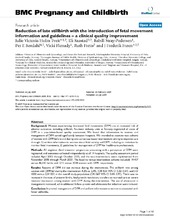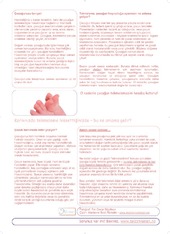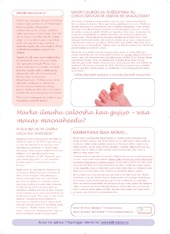| dc.contributor.author | Tveit, Julie Victoria Holm | en_US |
| dc.contributor.author | Saastad, Eli | en_US |
| dc.contributor.author | Stray-Pedersen, Babill | en_US |
| dc.contributor.author | Børdahl, Per E. | en_US |
| dc.contributor.author | Flenady, Vicki | en_US |
| dc.contributor.author | Fretts, Ruth | en_US |
| dc.contributor.author | Frøen, J. Frederik | en_US |
| dc.date.accessioned | 2015-01-21T12:37:27Z | |
| dc.date.available | 2015-01-21T12:37:27Z | |
| dc.date.issued | 2009-07-22 | eng |
| dc.identifier.issn | 1471-2393 | |
| dc.identifier.uri | https://hdl.handle.net/1956/9231 | |
| dc.description.abstract | Background: Women experiencing decreased fetal movements (DFM) are at increased risk of adverse outcomes, including stillbirth. Fourteen delivery units in Norway registered all cases of DFM in a population-based quality assessment. We found that information to women and management of DFM varied significantly between hospitals. We intended to examine two cohorts of women with DFM before and during two consensus-based interventions aiming to improve care through: 1) written information to women about fetal activity and DFM, including an invitation to monitor fetal movements, 2) guidelines for management of DFM for health-care professionals. Methods: All singleton third trimester pregnancies presenting with a perception of DFM were registered, and outcomes collected independently at all 14 hospitals. The quality assessment period included April 2005 through October 2005, and the two interventions were implemented from November 2005 through March 2007. The baseline versus intervention cohorts included: 19,407 versus 46,143 births and 1215 versus 3038 women with DFM, respectively. Results: Reports of DFM did not increase during the intervention. The stillbirth rate among women with DFM fell during the intervention: 4.2% vs. 2.4%, (OR 0.51 95% CI 0.32–0.81), and 3.0/ 1000 versus 2.0/1000 in the overall study population (OR 0.67 95% CI 0.48–0.93). There was no increase in the rates of preterm births, fetal growth restriction, transfers to neonatal care or severe neonatal depression among women with DFM during the intervention. The use of ultrasound in management increased, while additional follow up visits and admissions for induction were reduced. Conclusion: Improved management of DFM and uniform information to women is associated with fewer stillbirths. Correction available at: http://hdl.handle.net/1956/11822 | en_US |
| dc.language.iso | eng | eng |
| dc.publisher | BioMed Central | eng |
| dc.relation | http://hdl.handle.net/1956/11822 | |
| dc.rights | Attribution CC BY | eng |
| dc.rights.uri | http://creativecommons.org/licenses/by/2.0 | eng |
| dc.title | Reduction of late stillbirth with the introduction of fetal movement information and guidelines - a clinical quality improvement | en_US |
| dc.type | Peer reviewed | |
| dc.type | Journal article | |
| dc.date.updated | 2013-08-28T16:44:36Z | |
| dc.description.version | publishedVersion | en_US |
| dc.rights.holder | Copyright 2009 Tveit et al; licensee BioMed Central Ltd | |
| dc.rights.holder | Julie Tveit et al.; licensee BioMed Central Ltd. | |
| dc.source.articlenumber | 32 | |
| dc.identifier.doi | https://doi.org/10.1186/1471-2393-9-32 | |
| dc.identifier.cristin | 353305 | |
| dc.source.journal | BMC Pregnancy and Childbirth | |
| dc.source.40 | 9 | |







